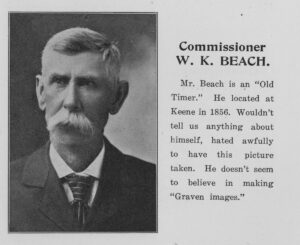
MISSION CREEK
 Free state advocates settled the Mission Creek Settlement, now called Keene, in 1855. Its numbers were increased in the fall of 1856 when a party from Wisconsin arrived with “Lane’s Army of the North”. Among them was the Ross family, including Senator Edmund G. Ross, who is featured in President John F. Kennedy’s book Profiles in Courage.
Free state advocates settled the Mission Creek Settlement, now called Keene, in 1855. Its numbers were increased in the fall of 1856 when a party from Wisconsin arrived with “Lane’s Army of the North”. Among them was the Ross family, including Senator Edmund G. Ross, who is featured in President John F. Kennedy’s book Profiles in Courage.
Stories passed down in the William and Elizabeth Beach family places one of the Mission Creek stations on the face of the bluff south of the creek on the Beach property. Beach descendants continue to own the property. The Kansas Farm Bureau has declared this farm to be the state’s oldest that is still owned and operated by the original family. The station here was probably a crude shelter in the woods. The Beach log cabin was located a short distance west, on property now owned by a neighbor. Although they each had their own claims, the household consisted of William and Elizabeth and William’s son, Dr. Samuel E. Beach and his wife Jane McGregor Beach. The log cabin had a dirt floor and was so small that cooking had to be done outdoors.
William Beach died in Wisconsin and is buried there. His wife Elizabeth is buried in the Mission Creek Cemetery (Keene) overlooking the site where 150 years ago she helped those seeking freedom. William’s son, Dr. Samuel E. Beach enlisted in the 8th Regiment, Kansas Volunteer Infantry as 1st assistant surgeon. He was taken prisoner while in charge of the wounded at Chickamauga. He died there of disease Nov. 4th 1863. A letter from O.W. Little to Wilbur Siebert, the well-known Underground Railroad researcher, in the Siebert papers at the Ohio Historical Society, gives further information about the UGRR in this neighborhood. Little says that George Ross, brother of Senator Edmund G. Ross, sheltered slaves that had probably come from the Auburn station, as did Harvey Loomis and Dr. Beach. He says that Ettie Beach Snyder remembers hearing a story “telling of two valuable slaves who were brought to their home from Auburn, one being kept at their place all winter, the other at the Loomis place. A letter was received from one of them after they got to Canada.”
Fugitives traveling from Auburn or Mission Creek to the Wabaunsee settlement probably crossed Mill Creek either at Waterman’s crossing south of present Maple Hill, or at a crossing just east of the bridge on Snokomo Road. From here the route, including that of Leonhardt’s Last Train, headed northwest where it joined the military road that ran between Topeka and Fort Riley. John Fremont was the first to record this route in 1843. Ruts from the trail can still be seen in the Bolton Wildlife Preserve and in pastures along the route. As the trail descends into the Kaw valley it crossed the eastern side of Mount Mitchell and past the cabins of Joshua Smith and Captain William Mitchell.
